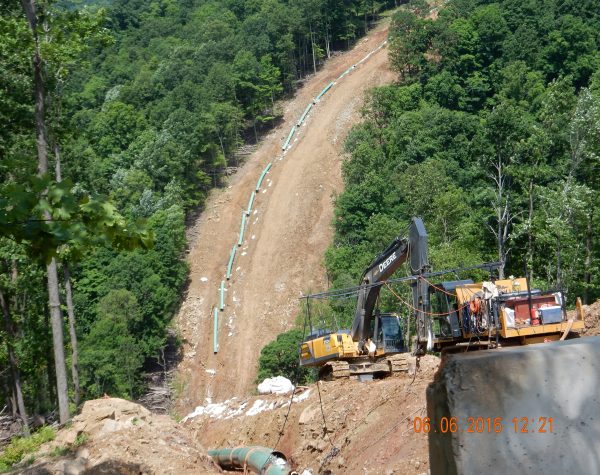 This is a guest blog by OVEC member April Keating, with the Mountain Lakes Preservation Alliance
This is a guest blog by OVEC member April Keating, with the Mountain Lakes Preservation Alliance
The comment period on the high-pressure, 42-inch diameter Atlantic Coast Pipeline (ACP) comes to a close April 6. Anyone who made comments during the pre-filing period must submit those comments again, since the Federal Energy Regulatory Commission has essentially tossed those into a pile of “old business.”
If you are a landowner, you may have already commented. If you are not a landowner along the route, perhaps you are an abutter (one next to property on the pipeline). If you are neither of these things, perhaps you are still concerned about threats to water, safety, and public health, or future economic development. All of these are valid concerns. You should write to the FERC.
Abutters will face most of the same risks as affected landowners, without the offers of money for the use of their property—water contamination, stream degradation, soil contamination, danger of fire or explosion, lowered property value among them. You have a right to have your concerns heard.
Even those not directly abutting could be negatively affected. The incineration zone is 3600 feet from the pipeline center. Our high school sits within the incineration zone, as does our state police barracks.
The evacuation zone for a pipeline of this size is two miles. If you are wondering if your property is in the evacuation zone, you can consult the GIS layered maps at www.pipelineupdate.org. Does your community have an evacuation plan? If not, you might consider asking your county commission, local emergency planning commission, or office of emergency management to develop one. Better yet, consider joining one of these organizations, or even creating a planning commission in your community to address issues that are receiving short shrift.
The ACP project has many more costs than benefits, though you may have only heard about the benefits. Some of the drawbacks include millions in foregone economic development (who wants to start a small business in an incineration zone?), reduced property value (try selling your house when you tell prospective buyers they may be caught in a gas fire), and stream degradation (siltation during construction kills stream life). We have seen this happen with the Stonewall-Momentum gathering line.
The 75-foot permanent easement will be sprayed with herbicides that will runoff into streams, and you can’t put anything but a flower garden on it. The 42” monstrosity will cross the Buckhannon River, our water source, and tributaries 9 times, and cross over miles of underground mines.
The pipeline is buried only feet below the surface, but how far below our streams will it be built? This question has been posed to Dominion by city officials and has yet to be answered. Will it be deep enough to protect the stream bed from going under, or will it be deep enough to connect with underground mines? Either way, our drinking water source is at risk.
What about jobs? Looking at the DEIS for this project (bear in mind this is info given to the FERC by Dominion) there could be 384 temporary jobs and only 22 permanent jobs. What is temporary? The Draft Environmental Impact Statement says the work tours will be 6-12 weeks long. Is it worth risking our water, safety, public health for a few temporary jobs?
How many employees will be locally hired? Not many, if you consider what happened with the Stonewall Momentum gathering line. Very few will be from West Virginia; most of them will be from the south and west. Skilled workers are moved from site to site, not hired locally.
Who will pay for the $5 billion project? Why, the ratepayers, of course, in the form of higher energy rates. Will it provide gas to our area? Nope. All of it is being sent out of state and offshore, so the companies owning it can make money selling it on the world market (where the going rate is higher than domestic). When that happens, our energy prices will rise.
What about tax revenue? Whatever money might come from this project will go to the state coffers, and they will dole it out as they please. Will it go for roads, schools, and other community projects? That is anyone’s guess, but the company has no stated plans to pay for roads or loss of life or property. The fact that they are a limited liability corporation means they won’t be liable for damages.
Don’t take my word for it; have a look at the DEIS yourself: https://www.ferc.gov/industries/gas/enviro/eis/2016/12-30-16-DEIS.asp
This project would have about 1,000 miles of access roads, effectively tripling its length. It will cross almost 2,000 waterways and affect the delicate Karst cavern and water filtration system. Moreover, we know that fracking is going to increase as soon as these projects get their certificate from the FERC. And we know what this means for our region: more water consumed, toxified, and injected, causing earthquakes, water and air contamination, and an exacerbated health crisis.
New York and Maryland have banned fracking. Have they done this because they want to live in the dark ages again? No, it is because they have looked at the evidence and wish to protect their communities. Surely, they want to develop energy and create jobs, but in a healthy, ethical, and sustainable way.
The only way to protect our water, safety, and public health and provide safe jobs is to invest in other types of energy—clean, green energy. Solar power provided more jobs in 2015 than coal, oil, and gas combined. Companies like Coalfield Development Corporation are using federal dollars from programs like the Power Plus Plan to train former coalfield workers to do the new jobs that are part of a sustainable future: installing solar panels, sustainable construction, reclamation, and remediation are just the tip of the iceberg. Talk about providing jobs—there it is! And guess what— we don’t have to live in the dark.
The deadline for comments is April 6 at 4:59 p.m. Comments can be submitted on paper or electronically, at www.ferc.gov. Search for 556-mile Atlantic Coast Pipeline, click on the link for the DEIS, and choose the docket # for the project you wish to comment upon. Most people use the pipeline itself (CP15-554), but the 37-mile Supply Header Project in Marshall, Wetzel, and, Doddridge are also part of the picture.










